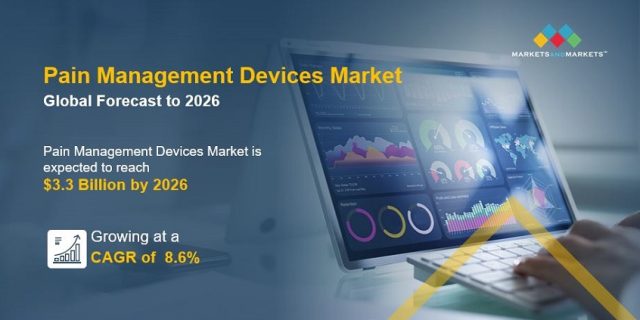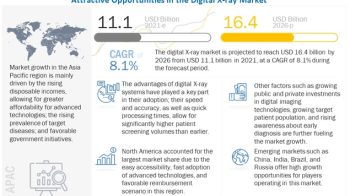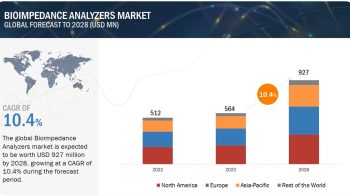
The global pain management devices market is on a robust growth trajectory, with a projected value of USD 3.3 billion by 2026, showcasing a notable increase from USD 2.2 billion in 2021. This growth is expected to be driven by a compound annual growth rate (CAGR) of 8.6% during the forecast period. Pain management devices play a crucial role in addressing both chronic and acute pain experienced by individuals afflicted with various diseases such as cancer, neurological disorders, and musculoskeletal disorders.
Download PDF Brochure: https://www.marketsandmarkets.com/pdfdownloadNew.asp?id=91418163
These innovative devices offer effective solutions to manage pain, enabling patients to regain their ability to perform everyday activities and reducing their reliance on oral pain medications. By doing so, pain management devices have the potential to significantly enhance the quality of life for individuals grappling with these debilitating conditions.
Despite the promising growth prospects, there are certain challenges that may impede the market’s progress. One such challenge is the occurrence of product recalls. Although rare, these recalls can impact consumer confidence and hinder market growth. It becomes crucial for manufacturers to maintain stringent quality control measures and comply with regulatory standards to minimize such incidents and uphold customer trust.
The pain management devices market is growing for several reasons:
1.Increasing prevalence of chronic pain: Chronic pain conditions such as arthritis, back pain, neuropathic pain, and cancer-related pain are becoming more common due to factors such as aging populations, sedentary lifestyles, and the rise in chronic diseases. As a result, there is a growing demand for effective pain management solutions.
2.Technological advancements: There have been significant advancements in pain management devices, including the development of innovative technologies such as neurostimulation devices, implantable drug delivery systems, and portable pain relief devices. These technological advancements have improved the efficacy and convenience of pain management, attracting more patients and healthcare providers.
3.Non-invasive and drug-free alternatives: With concerns about opioid addiction and the side effects of long-term medication use, there is a growing interest in non-invasive and drug-free pain management alternatives. Pain management devices offer non-pharmacological approaches to pain relief, such as electrical stimulation, heat therapy, and cold therapy, which appeal to patients seeking non-drug options.
4.Growing geriatric population: The global population is aging, and older individuals are more prone to chronic pain conditions. The elderly population often seeks pain relief options that allow them to maintain their independence and improve their quality of life. Pain management devices provide a viable solution for managing pain in older adults.
5.Increasing healthcare expenditure: Governments and healthcare organizations are investing more in pain management due to the high economic burden of chronic pain. Pain can significantly impact productivity and quality of life, leading to increased healthcare costs. Pain management devices offer a cost-effective approach compared to long-term medication or invasive procedures, driving their adoption.
6.Favorable reimbursement policies: Reimbursement policies and insurance coverage for pain management devices have improved in many countries. This has made pain management devices more accessible and affordable for patients, further contributing to market growth.
Opportunities: High growth in emerging markets
Emerging markets present significant opportunities for the growth of the pain management devices market. These markets are poised to experience remarkable expansion due to several factors. Firstly, there is an increasing awareness among individuals about the benefits of pain management devices, leading to a higher demand for these products. Additionally, rising disposable incomes in these regions allow for greater affordability and accessibility to pain management devices, further contributing to market growth.
Manufacturers are capitalizing on these opportunities by offering improved products and services at competitive prices, catering to the growing demand in emerging markets. This strategy not only drives sales but also fosters market expansion by reaching a larger consumer base.
Government initiatives aimed at enhancing healthcare access and affordability also play a crucial role in fueling the demand for pain management devices, particularly in regions like the United States, where the Affordable Care Act (ACA) has made healthcare more accessible to a wider population. Such initiatives create a conducive environment for the adoption of pain management devices and spur market growth.
Request Sample Pages: https://www.marketsandmarkets.com/requestsampleNew.asp?id=91418163
Furthermore, technological advancements continue to revolutionize the pain management devices market. The development of smart pain management devices, leveraging technologies such as Internet of Things (IoT) and artificial intelligence, presents new opportunities for the industry. These advanced devices offer enhanced features, remote monitoring capabilities, and personalized treatment options, thereby improving patient outcomes and driving market expansion.
Related Links
https://www.marketsandmarkets.com/Market-Reports/pain-management-devices-market-91418163.html

